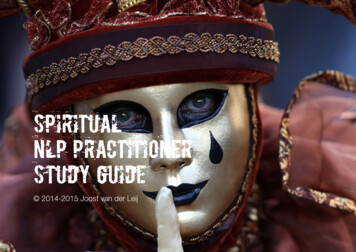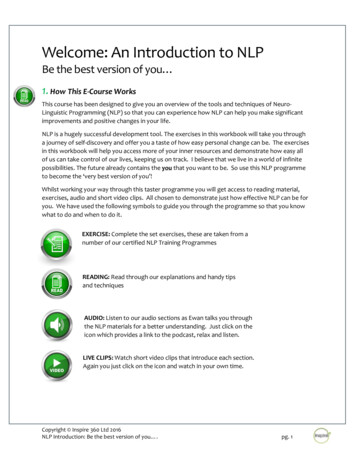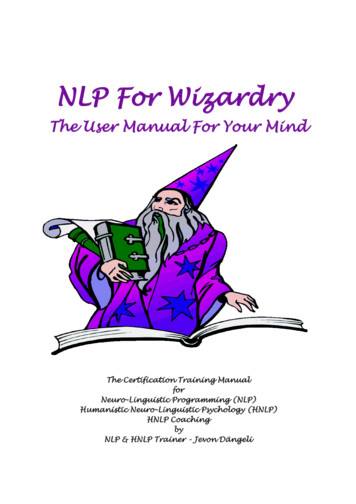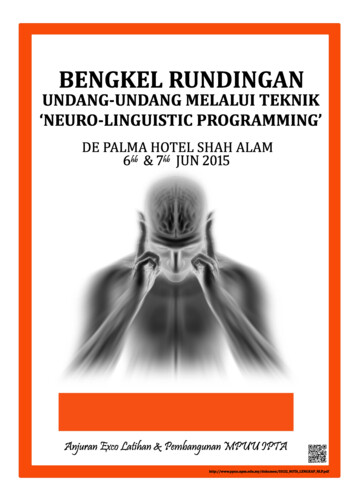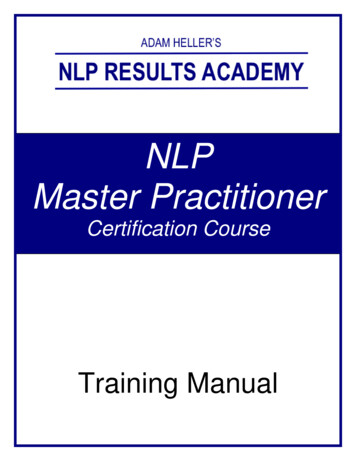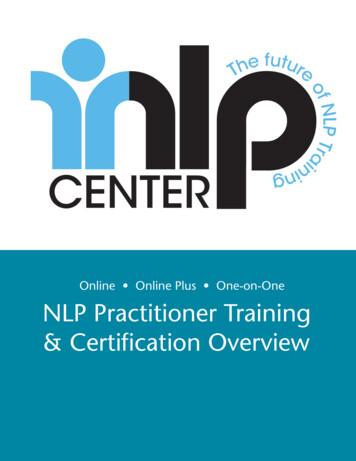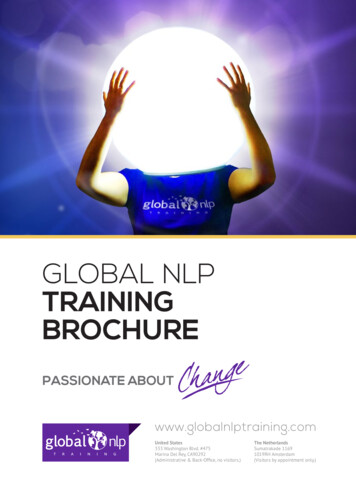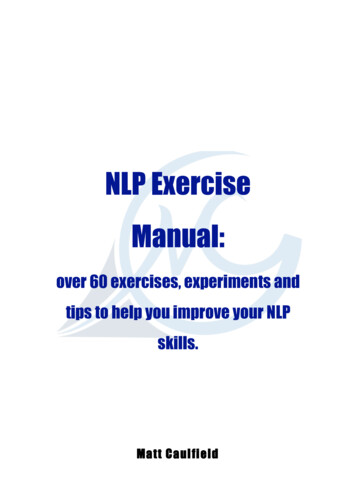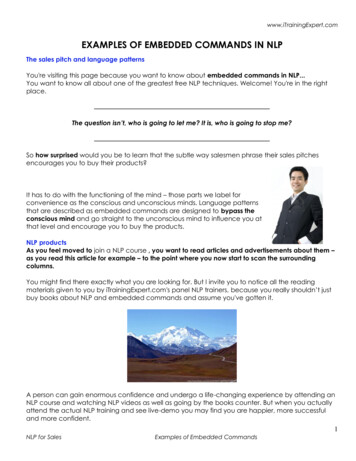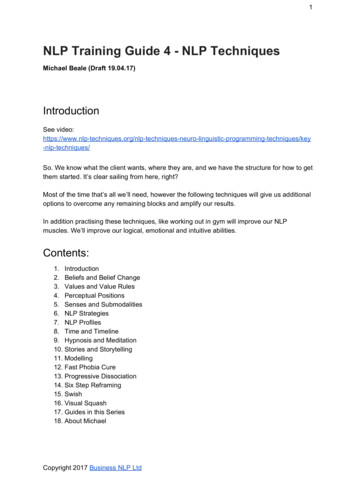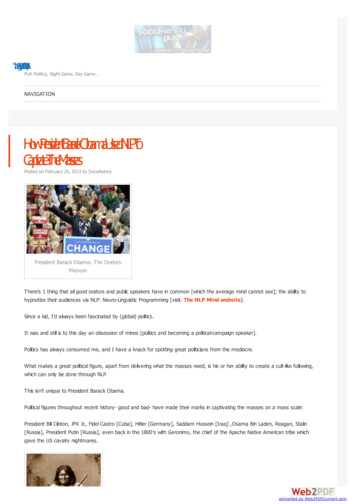
Transcription
Welcome, to yourNLPPractitioner CertificationPre-Study ProgrammeThank you for using NLP World as your learning provider in NLP.NLP World is a company which progressively provides pre-study through memorysticks or other media storage devices. The slide sections mentioned on the mediastorage devices are obsolete.The manual is to be used as a reference point only, as the MP3 tracks will guide youthrough the training. The Videos can be viewed when you have listened to thesections on the MP3s. Please locate them on the video/movie section in the memorysticks or media storage device.Terry Elston –Managing DirectorPlease note: We have recently reformatted our manual as a result of listening to therequirements of our delegates, some of whom felt it would be useful to have it following thesame order as the MP3 tracks/CDs. Therefore, please be aware that the page numbers onthe audio medium may not always correspond to those of the revised manual. To help youquickly refer easily and effortlessly to the required location an index has been included at thefront of the manual.Note: As some MP3 tracks and are live recordings, sound changes will naturally occur. Wehave included a live version of the training in your media package plus a studio recording soyou can choose which version you prefer.
The NLP World 7 Day Practitioner Certification TrainingThe NLP World Practitioner Training Manual . Version 2010Copyright 2003, NLP World Terry Elston
The NLP World 7 Day Practitioner Certification TrainingNLP Practitioner Certification TestPlease complete this test PRIOR to arriving at the training. We will send you out acopy of this test via email so you can utilize your laptop or PC to complete. If youdon’t have your electronic version, call/email us and we will e-mail you thequestions so you can type the answers into a computerYou can find answers here as well as on MP3’s and .Date: .1.List six presuppositions of NLP.2.What is the law of requisite variety?3.Which of the following descriptions are sensory based (S) and which arehallucinations/mind reads (H)? Bear in mind sensory based is based onfact.Her lips puffed and the muscles on her face tightened.She was relieved.The volume of his voice was diminished.She looked guilty.He looked cold.He showed a sense of security.His pupils dilated.4.List six modalities of calibration (i.e. skin tonus etc)5.What is the difference between voice tone, tempo and timbre?6.What is rapport? How is it useful?7.List five things to match in getting rapport.8.What is cross over mirroring?9.For each of the following predicate, identify whether they are visual (V),auditory tonal (At), kinaesthetic (K), olfactory (O), gustatory (G), or auditorydigital (Ad) Some of these may be multiples (E.g. Ad/V)so list all.The NLP World Practitioner Training Manual . Version 2010Copyright 2003, NLP World Terry Elston
The NLP World 7 Day Practitioner Certification ebitterBrilliant10, Translate the following sentences into a different representational system.Things look good.It is so quiet that you can hear a pin drop.You are really fired up!That sounds like a great idea.People don't see me as I see myself.Your words leave a sour taste in my mouth.11. What is "overlapping representational systems" and when would you usethe pattern?12.What are the 9 keys to achievable outcomes? (write them out please)What is the purpose of them?13.Prepare a hypnotic phrase for each of the following Milton Model Patterns:Mind readingConversational postulateCause and effectSelectional Restriction ViolationLack of Referential IndexDeletionAmbiguityEmbedded CommandExtended QuotesTag Question14.What is the "Meta Model"?15.What are the three processes of internalizing on which the meta model isbased?The NLP World Practitioner Training Manual . Version 2010Copyright 2003, NLP World Terry Elston
The NLP World 7 Day Practitioner Certification Training16.Identify the Meta Model violations/patterns (I.E. Cause and effect etc.) ineach of the following sentences and indicate what the appropriate MetaModel challenge would be? (E.G. He makes me happy – Simple deletion –How does he make you happy)?He makes me happy.It's wrong to cheat.I regret my decision.Nobody ever pays any attention to me.Sue cares for me.Susan hurt me.I'm angry.I should study harder.17.How would you ‘chunk’ someone up beyond their current problem(perhaps in negotiation). Write down the phrases you would use. SeeHierarchy of Ideas section.18.List six (6) visual and six (6) kinaesthetic and (6) auditory submodalities.19.Explain the difference between contrastive analysis and mapping across?20.What is meant by "Primary Representational System," and how do youdetect it?21.What is meant by "Lead Representational System," and how do you detectit?22.What is the difference between association and dissociation, and when is ituseful to use either?23.What are perceptual positions? (Name the positions).24.What is an anchor?25.What is “all you need” when it comes to conversational anchoring? (Seemanual).26.What is the first choice (number one in list) words to use whenconversational anchoring? (see manual).27.What is chaining anchors and when do you use it?The NLP World Practitioner Training Manual . Version 2010Copyright 2003, NLP World Terry Elston
The NLP World 7 Day Practitioner Certification Training28.What is "state" and why is it important?29.What is a "pattern interrupt" and when is it useful? (this is not in the manual,see the glossary on my website)30.Describe the following frames and tell when to use them: (in the conscioususe of language section).a. Evidence b. Backtrack c. Relevancy d. Contrast e. Ecology f. As if31.Describe how you would discover how your client stores time. Look inmanual to find script. Write out the whole script then, elicit your own TimeLine and draw/design a picture of it on your paper or write it in text.32.What is a phobia? Full definition please.33Fill in the eye patterns of a normally organized right handed person (drawor write in text).34What is a strategy?35What is the formal script for eliciting a strategy? (In manual – “text forformal strategy elicitation”)36What is a "reframe" and when is it useful?37What is the difference between a "Context" and a "Content" reframe?38What is the agreement frame and when would you use it? (in manual conscious use of language section)39What is a conditional close and when would you use it? (in manual conscious use of language section)40Why is "Intent" important in negotiations? (see NLP negotiations andmeeting section)41What is Neuro Linguistic Programming?The NLP World Practitioner Training Manual . Version 2010Copyright 2003, NLP World Terry Elston
Table of ContentsThe History of NLP . 4What is NLP? . 5Definition of NLP . 9State V Goal . 10NLP Communication Model . 11Five Principles for Success . 12Keys to an Achievable Outcome . 13Well-Formed Conditions . 14Prime Directives of the Unconscious Mind . 15Presuppositions Of NLP . 17Observing Other People . 18Rapport . 19Representational Systems . 24Representational System. 25Favoured Representational Systems . 28Predicates . 29List of Predicates . 30List of Predicate Phrases . 31Intonation Patterns . 32Presuppositions in Language. 32Think . 36Hierarchy of Ideas . 37Metaphor Outline . 38Milton Model . 40Hypnotic Language Patterns . 40The Meta Model . 43Meta Model III . 44SubModalities . 45SubModalities Checklist. 46Examples of Triggers in NLP Contexts . 49SubModalities Like to Dislike Script. 50SubModalities Belief Change Script . 51Swish Pattern Big Picture . 52
The NLP World 7 Day Practitioner Certification TrainingKeys to Successful Swish Patterns . 52SubModalities Swish Pattern Script . 53Dissociative Technique . 54Conversational Anchoring. 55Accessing Positive States . 56Anchoring, Kinaesthetic Version . 57Application of a Conversational or Tactile Anchor . 58Collapsing Anchors . 60State Script for Tactile Anchoring . 63States for Stacking Anchors . 63Collapse Anchors for Tactile Anchoring . 64Chaining Anchors . 65New Orleans Flexibility Drill . 66NLP Change Personal History . 67Physiology of Excellence . 68The Ring of Power . 68Reframing . 69Context Reframe . 69Meaning Reframe . 69Six-Step Reframe . 70Parts Integration. 73Eye Pattern Chart . 74Eye Pattern Questions . 75Strategies . 77Strategies Theory . 80Types of Strategies . 81The T.O.T.E. Model . 82The Steps in a Strategy Elicitation . 85Strategy Elicitation . 86Text for Formal Strategy Elicitation . 87A Formal Elicitation — Demonstration. 87Elicitation Demonstration 2 . 90Deep Love Strategy . 97Structural Well-Formedness Conditions . 97Questions to Elicit Strategies . 98The NLP World Practitioner Training Manual . Version 2010Copyright 2003, NLP World Terry Elston
The NLP World 7 Day Practitioner Certification TrainingInstalling or Changing Strategies . 98Typical Problems in Motivation Strategies . 99Typical Problems with Decision Strategies. 99Strategy Elicitation From Eye Patterns . 100Additional Ideas in Eliciting Strategies . 101Strategy Utilization . 102Embedded Commands . 103Strategy Design . 105Strategy Installation . 107Motivation Strategies . 108NLP Notation . 110The 6 Step Sales Strategy . 112Negotiating - Influencing . 115Handling Objections . 118The Meeting Format . 119Before the Meeting . 119Opening the Meeting . 120Closing the Meeting . 121The Conscious Use of Language . 122Plus ‘frames’ of language designed to assist you negotiate with groups . 122Learning Strategies . 123Spelling Strategies . 124Spelling Strategies - Installing . 125Suggested Family Therapy Model . 127Elicitation of the Time Line #1 . 129First Test of Elicitation . 130Discovering A Cause . 131Scripts and Processes . 132Visual TBT . 133Procedure: . 133General Reframes . 134Steps for Putting A Single Goal In Your Future . 135Event . 136Fast Phobia Model . 136NLP Model of Therapy . 137The NLP World Practitioner Training Manual . Version 2010Copyright 2003, NLP World Terry Elston
The NLP World 7 Day Practitioner Certification TrainingNeuro-Linguistic Programming Certification Standards . 138NLP Associate Level. 138NLP Practitioner Level . 138NLP Master Practitioner Level . 139NLP Trainer Level . 140NLP Glossary . 141My Notes . 150The NLP World Practitioner Training Manual . Version 2010Copyright 2003, NLP World Terry Elston
The NLP World 7 Day Practitioner Certification Training4The History of NLPKorzybskiGeneral rTOTE ModelPavlovBehaviouralPsychologyHypnoticLanguage PatternsThe Structureof Magic I & IIPatterns I & IISynaesthesiaPatternEmbeddedCommandsFrogs intoPrinces1975Fritz PerlsGestalt TherapyDebate about personal power andits place in therapyStrategiesNLPVolume IChangePersonalHistoryRepSystemsBateson & HaleyEcologyEyePatterns1979Virginia SatirFamily TherapyGordonMetaphorsMiller 7 2ReframingReframingJohn OverdurfSub ModalitiesUsing Your Brainfor a ChangeTime BasedTechniquesTime BasedTechniquesProductsMagic in ActionTrance-formationsTrance InductionDilts1980LanguagePatterns1982Applications ofNLPRoots of NLP1985Meta ProgramsRichard & LeslieSleight of MouthPolya, J.S. Mill1988The NLP World Practitioner Training Manual . Version 2010Copyright 2003, NLP World Terry Elston
The NLP World 7 Day Practitioner Certification Training5What is NLP?A Model of Communication and PersonalityNeuro-Linguistic Programming (NLP) began as a model of how we communicate toourselves and others. It was originally developed by Richard Bandler, John Grinder andothers. This model explains how we process the information that comes into us from theoutside. The belief is that “The map is not the territory.” And so the internalrepresentations that we make about an outside event are not necessarily the eventitself.Typically, what happens is that there is an external event and we run that eventthrough our internal processing. We make an Internal Representation (I/R) of thatevent. That I/R of the event combines with a physiology and creates a state. “State”refers to the internal emotional state of the individual Ñ a happy state, a sad state, amotivated state, and so on. Our I/R includes our internal pictures, sounds and dialogue,and our feelings (for example, whether we feel motivated, challenged, pleased,excited, and so on). A given state is the result of the combination of an internalrepresentation and a physiology. So what happens is that an event comes in throughour sensory input channels which are:VisualIncluding the sights we see or the way someone looks at us;AuditoryIncluding sounds, the words we hear and the way that people say thosewords to us (unless you specifically want variety in form);KinaestheticOr external feelings which include the touch of someone or something,the pressure, and texture;OlfactoryWhich is smell;GustatoryWhich is tasteThe external event comes in throughout sensory input channels and it is filtered and weprocess the event. As we process the event, we delete, distort, and generalize theinformation that comes in, according to any number of several elements that filter ourperception.DeletionDeletion occurs when we selectively pay attention to certain aspects of our experienceand not others. We then overlook or omit others. Without deletion, we would be facedwith much too much information to handle with our conscious mind.The NLP World Practitioner Training Manual . Version 2013Copyright 2003, NLP World Terry Elston
The NLP World 7 Day Practitioner Certification Training6DistortionDistortion occurs when we make shifts in our experience of sensory data by makingmisrepresentations of reality. In Eastern philosophy there is a well-known story ofdistortion in the rope versus snake analogy. A man walking along the road sees whathe believes to be a snake and yells “SNAKE.” However, upon arriving at that place he isrelieved as he discovers that what he sees is really only a piece of rope.Distortion also helps us in the process of motivating ourselves. The process of motivationoccurs when we actually distort the material that has come into us that has beenchanged by one of our filtering systems.GeneralizationThe third process is generalization, where we draw global conclusions based on one ortwo experiences. At its best, generalization is one of the ways that we learn, by takingthe information we have and drawing broad conclusions about the meaning of theeffect of those conclusions.Normally, the conscious mind can only handle 7 (plus or minus 2) items of information atany given time. Of course, many people can’t even handle this number, and I knowpeople who are a “1 (Plus or minus 2).” How about you? Try this: Can you name morethan 7 products in a given product category, say cigarettes? Most people will be ableto name 2, maybe 3 products in a category of low interest and usually no more than 9in a category of high interest. There is a reason for this. If we didn’t actively deleteinformation all the time, we’d end up with much too much information coming in. Infact, you may have even heard that psychologists say that if we were simultaneouslyaware of all of the sensory information that was coming in, we’d go crazy. That’s whywe filter the information.So, the question is, when two people have the same stimulus, why don’t they have thesame response? The answer is, because we delete, distort, and generalize theinformation from the outside.We delete, distort and generalize the information that comes in from our senses basedon one of five filters. The filters are, Meta Programs, belief systems, values, decisions,and memories.Meta-programsThe first of these filters is Meta Programs. Knowing someone’s Meta Programs canactually help you clearly and closely predict people’s states, and therefore predict theiractions. One important point about Meta Programs: they are not good or bad, theyare just the way someone handles information.The NLP World Practitioner Training Manual . Version 2013Copyright 2003, NLP World Terry Elston
The NLP World 7 Day Practitioner Certification Training7ValuesThe next filter is values. They are essentially an evaluation filter. They are how wedecide whether our actions are good or bad, or right or wrong. And they are how wedecide about how we feel about our actions. Values are arranged in a hierarchy withthe most important one typically being at the top and lesser ones below that. We allhave different models of world (an internal model about the world), and our values arethe result of our model of the world. When we communicate with ourselves or someoneelse, if our model of the world conflicts with our values or their values, then there’s goingto be a conflict. Richard Bandler says, “Values are those things we don’t live up to.”Values are what people typically move toward or away from (see Meta Programs).They are our attractions or repulsion’s in life. They are essentially a deep, unconsciousbelief system about what’s important and what’s good or bad to us. Values changewith context too. That is, you probably have certain values about what you want in arelationship and what you want in business. Your values about what you want in oneand in the other may be quite different. And actually, if they’re not, it’s possible thatyou may have trouble with both. Since values are context related, they may also bestate related, although values are definitely less related to state than are beliefs.BeliefsThe next filter is beliefs. Beliefs are generalizations about how the world is. One of theimportant elements in modelling is to find a person’s beliefs about the particularbehaviour we are trying to model. Richard Bandler says “Beliefs are those things wecan’t get around.” Beliefs are the presuppositions that we have about the way theworld is that either create or deny
NLP Practitioner Certification Pre-Study Programme Thank you for using NLP World as your learning provider in NLP. NLP World is a company which progressively provides pre-study through memory sticks or other media storage devices. The slide sect
